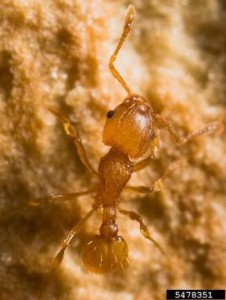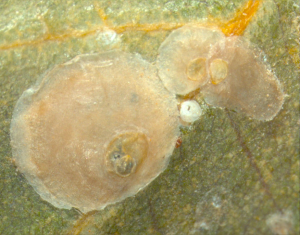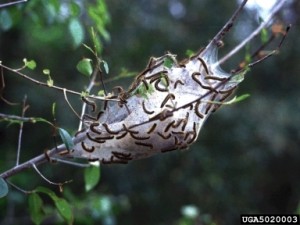California Pest Rating for

Photo credit: Alessandra Rung, Scale Insects, USDA APHIS ITP, Bugwood.org
Ripersiella hibisci (Kawai & Takagi): Root Mealybug
Hemiptera: Rhizoecidae
Pest Rating: A
PEST RATING PROFILE
Initiating Event:
Ripersiella hibisci is frequently intercepted by CDFA and is presently assigned a temporary rating of “Q”. A pest rating proposal is required to assign a permanent pest rating.
History & Status:
Background: Ripersiella hibisci is a polyphagous mealybug that feeds exclusively on the roots of plants1,2. This mealybug inhabits the rootball or the area between the rootball and the plant container where it is difficult to detect1. Heavily infested plants show poor growth, wilt, and turn yellow or grey1. Plants may be prevented from flowering and eventually die1. Known hosts include: Amaryllidaceae: Crinum asiaticum2; Apocynaceae: Nerium oleander2; Araceae: Dieffenbachia spp.2; Arecaceae: Areca spp.2, Butia capitata (PDR 1316475), Caryota sp. (1075104), Chambeyronia macrocarpa (1316833), Dypsis decaryi (1253915), Gronophyllum spp.2, Ptychosperma macarthurii (1075011), Phoenix roebellenii2, Phoenix canariensis2, Ravenea rivularis (1075143), Rhapis excelsa (1040975), Rhapis multifida (1308317), Rhapis spp.2, Sabal spp.2, Syragus romanzoffiana (1122973), Wodyetia bifurcata (1317460); Bromeliaceae: Cryptanthus spp.2; Commelinaceae: Dichorisandra thyrsiflora2; Cyperaceae: Carex spp.2; Ericaceae: Rhododendron sp.1; Geraniaceae: Pelargonium spp.2; Lythraceae: Cuphea hyssopifolia2, Punica granatum1; Malvaceae: Hibiscus rosa-sinensis2; Marantaceae: Calathea sp.1; Moraceae: Ficus benjamina (1230171), Ficus sp.1; Oleaceae: Ligustrum ovalifolium1; Poaceae: Hakonechloa macra2; Rhamnaceae: Sageretia theezans1; Rubiaceae: Serissa foetida1, Serissa spp.2; Solanaceae: bell pepper (Capsicum annuum (58665)); Ulmaceae: Ulmus parvifolia1, Zelkova serrata1, Zelkova spp.2; Zingiberaceae: Zingiber sp. (1188341). Ripersiella hibisci may be transported long distances when infested plants are moved.
Worldwide Distribution: Ripersiella hibisci is probably native to China or Japan. From there it has spread to Hawaii, Florida, and Puerto Rico2.
Official Control: Ripersiella hibisci is listed as a quarantine pest by the European Union1.
California Distribution: Ripersiella hibisci has not been found in the environment of California.
California Interceptions: Ripersiella hibisci has been intercepted 275 times by CDFA on plants from Hawaii, Florida, Texas, and Arizona. Most interceptions have occurred on palms.
The risk Ripersiella hibisci (root mealybug) would pose to California is evaluated below.
Consequences of Introduction:
1) Climate/Host Interaction: Host plants for Ripersiella hibisci are grown throughout most of California. As it feeds on roots below ground, the mealybug has some protection from temperature extremes. Root mealybug receives a High (3) in this category.
Evaluate if the pest would have suitable hosts and climate to establish in California. Score:
– Low (1) Not likely to establish in California; or likely to establish in very limited areas.
– Medium (2) may be able to establish in a larger but limited part of California.
– High (3) likely to establish a widespread distribution in California.
2) Known Pest Host Range: Ripersiella hibisci is known to feed on at least 40 species of plants in 20 families. It receives a High (3) in this category.
Evaluate the host range of the pest. Score:
– Low (1) has a very limited host range.
– Medium (2) has a moderate host range.
– High (3) has a wide host range.
3) Pest Dispersal Potential: Mealybugs are capable of rapid reproduction and can be transported long distances when infested plants or fresh plant parts are moved. Ripersiella hibisci may also disperse locally by the crawlers being flushed out of plant pots when the plants are watered, then crawling into adjacent plant pots through drainage holes in their bases; also through wind, or by hitchhiking on clothing, equipment, or animals1. Its cryptic habits mean that root mealybug may easily be dispersed by trade in infested plants without being detected. Ripersiella hibisci receives a High (3) in this category.
Evaluate the natural and artificial dispersal potential of the pest. Score:
– Low (1) does not have high reproductive or dispersal potential.
– Medium (2) has either high reproductive or dispersal potential.
– High (3) has both high reproduction and dispersal potential.
4) Economic Impact: Ripersiella hibisci is likely to lower the value of nursery stock by disfiguring plants or reducing plant quality. It is also likely to increase production costs of nursery stock. Root mealybug may also disrupt markets. Ripersiella hibisci receives a Medium (2) in this category.
Evaluate the economic impact of the pest to California using the criteria below. Score:
A. The pest could lower crop yield.
B. The pest could lower crop value (includes increasing crop production costs).
C. The pest could trigger the loss of markets (includes quarantines).
D. The pest could negatively change normal cultural practices.
E. The pest can vector, or is vectored, by another pestiferous organism.
F. The organism is injurious or poisonous to agriculturally important animals.
G. The organism can interfere with the delivery or supply of water for agricultural uses.
– Low (1) causes 0 or 1 of these impacts.
– Medium (2) causes 2 of these impacts.
– High (3) causes 3 or more of these impacts.
5) Environmental Impact: Ripersiella hibisci is not expected to lower biodiversity, disrupt natural communities, or change ecosystem processes. It may feed on threatened or endangered plants such as white sedge (Carex albida) and Tompkins’s sedge (Carex tompkinsii). Root mealybug is not expected to disrupt critical habitats. It may trigger treatment programs in the nursery industry and urban areas. Host plants of Ripersiella hibisci are widely grown as ornamentals in California and may be significantly impacted. The mealybug receives a High (3) in this category.
Evaluate the environmental impact of the pest on California using the criteria below.
A. The pest could have a significant environmental impact such as lowering biodiversity, disrupting natural communities, or changing ecosystem processes.
B. The pest could directly affect threatened or endangered species.
C. The pest could impact threatened or endangered species by disrupting critical habitats.
D. The pest could trigger additional official or private treatment programs.
E. The pest significantly impacts cultural practices, home/urban gardening or ornamental plantings.
Score the pest for Environmental Impact. Score:
– Low (1) causes none of the above to occur.
– Medium (2) causes one of the above to occur.
– High (3) causes two or more of the above to occur.
Consequences of Introduction to California for Ripersiella hibisci (root mealybug): High (14)
Add up the total score and include it here.
–Low = 5-8 points
–Medium = 9-12 points
–High = 13-15 points
6) Post Entry Distribution and Survey Information: Ripersiella hibisci has never been found in California and receives a Not established (0) in this category.
Evaluate the known distribution in California. Only official records identified by a taxonomic expert and supported by voucher specimens deposited in natural history collections should be considered. Pest incursions that have been eradicated, are under eradication, or have been delimited with no further detections should not be included.
–Not established (0) Pest never detected in California, or known only from incursions.
–Low (-1) Pest has a localized distribution in California, or is established in one suitable climate/host area (region).
–Medium (-2) Pest is widespread in California but not fully established in the endangered area, or pest established in two contiguous suitable climate/host areas.
–High (-3) Pest has fully established in the endangered area, or pest is reported in more than two contiguous or non-contiguous suitable climate/host areas.
Final Score:
The final score is the consequences of introduction score minus the post entry distribution and survey information score: High (14)
Uncertainty:
Interceptions of Ripersiella hibisci by both California and Europe have yielded many new host records. It is likely that the host range of this mealybug will continue to expand.
Conclusion and Rating Justification:
Ripersiella hibisci has never been found in California and is likely to have significant economic and environmental impacts if it were to establish in the state. An “A” rating is justified.
References:
1 MacLeod, A. 2005. Rhizoecus hibisci. Data sheets on quarantine pests. European and Mediterranean Plant Protection Organization. http://www.eppo.int/QUARANTINE/insects/Rhizoecus_hibisci/DS_Rhizoecus_hibisci.pdf
2 Miller, Dug, Yair Ben-Dov, Gary Gibson, and Nate Hardy. ScaleNet. http://scalenet.info/validname/Ripersiella/hibisci/
Responsible Party:
Jason Leathers, 1220 N Street, Sacramento, CA, 95814, (916) 654-1211, plant.health[@]cdfa.ca.gov.
Comment Format:
♦ Comments should refer to the appropriate California Pest Rating Proposal Form subsection(s) being commented on, as shown below.
Example Comment:
Consequences of Introduction: 1. Climate/Host Interaction: [Your comment that relates to “Climate/Host Interaction” here.]
♦ Posted comments will not be able to be viewed immediately.
♦ Comments may not be posted if they:
Contain inappropriate language which is not germane to the pest rating proposal;
Contains defamatory, false, inaccurate, abusive, obscene, pornographic, sexually oriented, threatening, racially offensive, discriminatory or illegal material;
Violates agency regulations prohibiting sexual harassment or other forms of discrimination;
Violates agency regulations prohibiting workplace violence, including threats.
♦ Comments may be edited prior to posting to ensure they are entirely germane.
♦ Posted comments shall be those which have been approved in content and posted to the website to be viewed, not just submitted.
Pest Rating: A
Posted by ls



